B2B vs B2C Marketing. One often opposes the two main kinds of marketing but aren’t they more or less six of one and half a dozen of the other? Some time ago, Capgemini consulting, that used to be my employer at the turn of the 21st century, organised a meeting in Paris, France on the subject of B2B marketing as part of the release of their latest “Journal of Marketing Revolution”. During that conference, I took part in a round table discussion that brought together a panel of experts and filed practitioners. There I described the differences between B2B and B2C, based on my article for the consultancy firm, only available in French at the time. At a time when B2B marketing has such an important place in our digital and e-commerce economy, it was high time I translated it.
B2B vs B2C Marketing: Two Sides of the Same Coin?
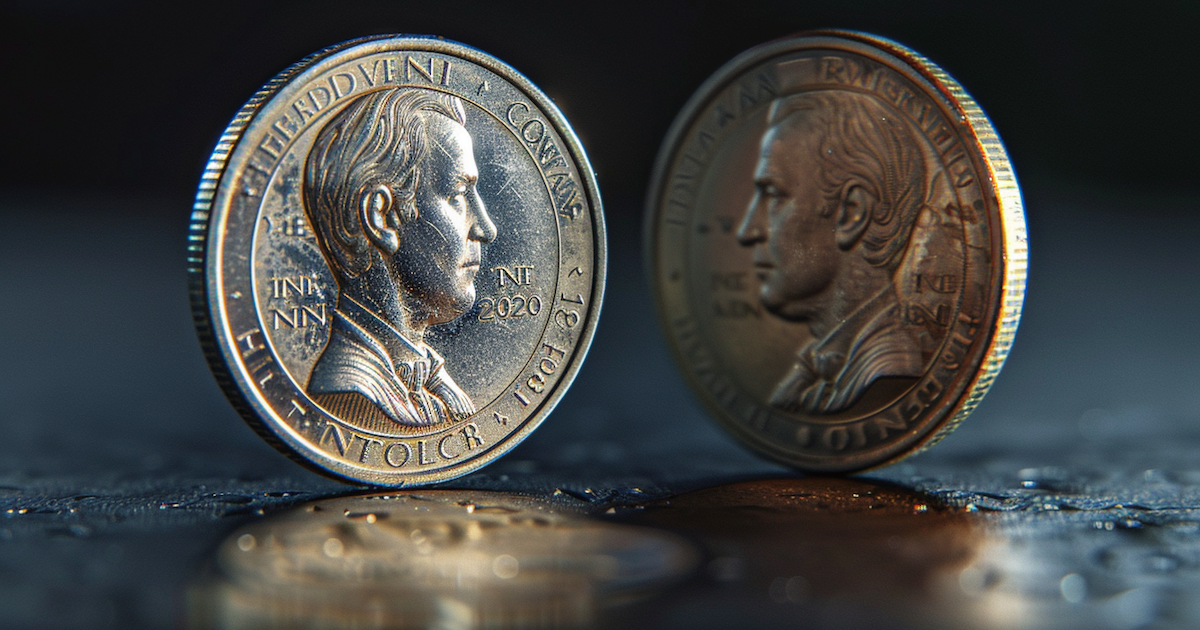
B2B vs B2C marketing?
What is B2B marketing, how similar and how different is it from B2C marketing? I took this opportunity to debunk a few inexorable myths about B2B marketing. But never before has B2B marketing been so radically transformed in terms of its practices, its evolution and the way in which relationships with customers and prospects are managed. In fact, there have never been so many demands in the field. Marketers are looking for solutions to their problems at a time when Business to Business marketing is in the process of emancipating itself from its big brother. This has not wavered since 2017, quite the contrary.

The Pioneer of Business-to-business Marketing: Regis McKenna
For many years, B2B marketing was the poor cousin of marketing. It was almost a case of practising B2B by default, and yet there was a demand for it. One could feel this right from the beginning, when I first started to be in business in the late 80s.
We first tried to apply B2C methods to these professional markets, but to no avail, such was the gap between the two. During one of my first B2B marketing projects in the manufacturing industry, I launched a complete study (desk + field research) with a semi-directive and a directive survey of a reasonable and varied sample of architects.
Anecdote from the Early Days of B2B Marketing
The product was a colour version of the now-infamous Eternit roofing product (side note: unfortunately, many of our friends died from working with asbestos for this firm, but we didn’t know that at the time). For this engagement, I had decided to customise a methodology borrowed from quantitative multi-criterion consumer analysis and to transpose it for Multiplan on a personal computer. It happened in 1983, needless to say, this was quite revolutionary at the time. This survey and my recommendations were instrumental in delivering a very rewarding ROI in the following years.
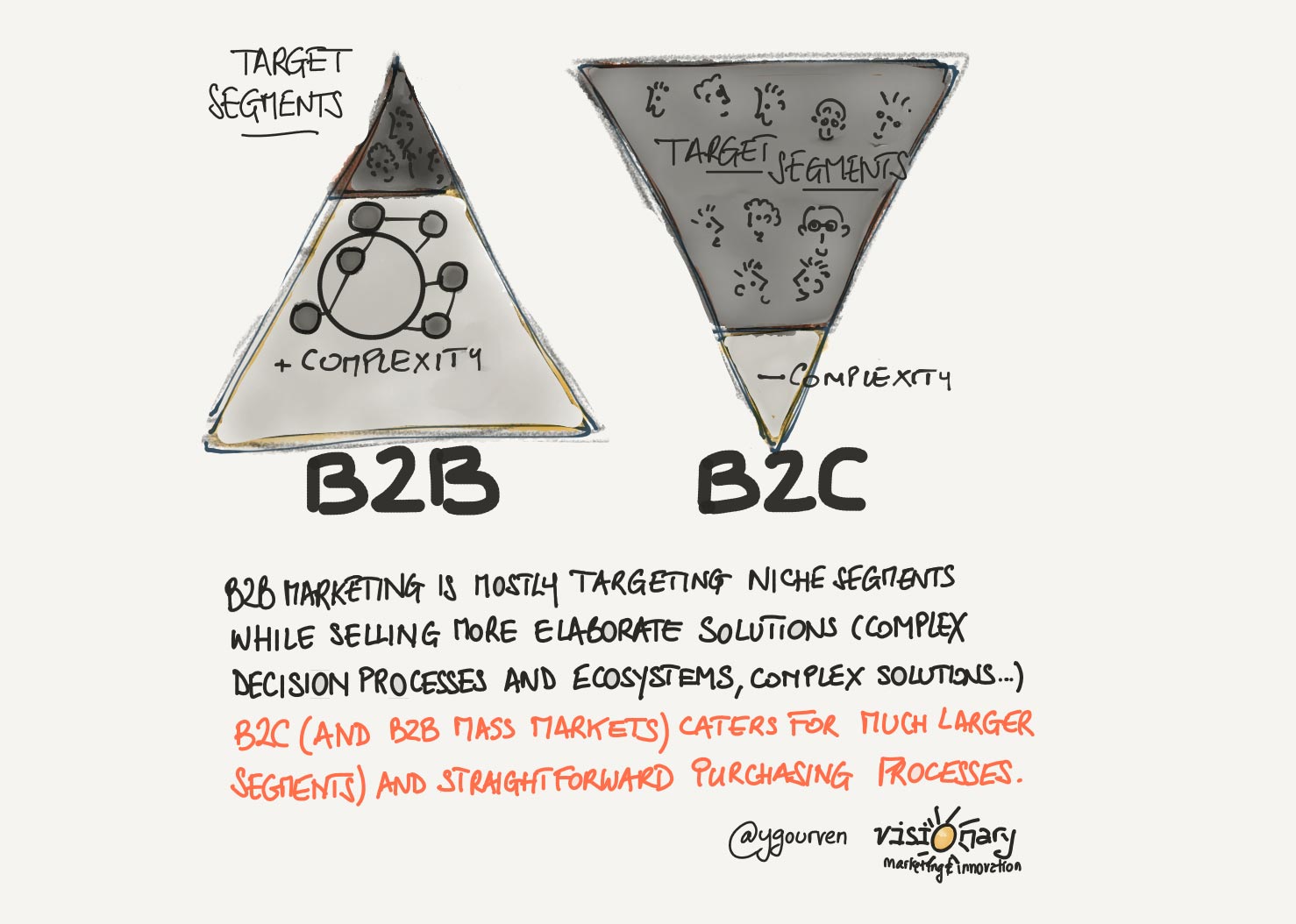
Of course, this methodology hadn’t been designed for that purpose. But it worked. With a bit of common sense and hindsight, I quickly came up with the right recommendations that helped us find the right set of colours to implement (and which, of course, contradicted all our initial assumptions).
Marketing Techniques in B2C vs B2B
Marketing methodology wasn’t really the real problem with B2B marketing in those days. Most of the issue originated from a low acceptance factor of methods that had essentially been pioneered for fast-moving consumer goods. “We aren’t selling hot cakes, you know!” and all that sort of things.
Approximately at the same time, a marketing genius, one I admire, Regis McKenna, who invented everything in B2B marketing and particularly high-tech marketing, was helping to launch one of the most iconic products of the past 50 years. I mean the Macintosh, in 1984.
A real genius he was. As he was instrumental in the take-off of Apple in the 1970s. Steve Jobs was not yet the marketing pro he later became. He also designed Intel’s Marketing strategy, and this at a time when it was believed that personal computers would never be a serious marketMarket definition in B2B and B2C - The very notion of "market" is at the heart of any marketing approach. A market can be defined..., and especially that they would never be used by professionals.
He not only believed in it, but even made a fortune by taking a percentage of sales as payment for the advertising he created. Indeed, Apple did not have enough revenue to cover these expenses at the time. Some of his business partners were a little concerned. He wasn’t and decided to work pro bono and wait for the harvest he’s sown. He wasn’t disappointed.
Who is into B2B vs B2C marketing? 3 raised their hands
A few years later, 15 years ago, I was presenting my B2B marketing methods for web services developed for an Orange Business Services subsidiary at a marketing conference in Istanbul. I went for a trick that I thought was clever and proved otherwise.
As I was beginning my pitch, I asked the audience: “Who here works in B2B marketing? ” That was probably the worst decision that I ever made, and a good lesson it taught me.
Barely 3 people in the crowd raised their hands even though there were nearly 1000 delegates in the room. B2B marketing was not (yet) on the agenda.
Things Have Changed a Lot in the B2B World
But things have changed since then. In a spectacular turn of events, B2B marketing, and particularly high-tech marketing, is once again flavour of the month. Back in 2017, Amazon was finally announcing record consumer profits after 22 years in business. It should be noted that its B2B business of cloud server sales (AWS) has been much quicker to turn a profit. Enough to boost the results of this new distribution giant. All the big players had been sniggering in the background for quite a long time.
Amazon Web Services, B2B Marketing With a Credit Card
In 2024, as I’m writing these lines, Amazon is thriving and guess what: AI is the new force behind these humongous profits. And behind AI one finds cloud computing and especially its market leader, AWS. B2B marketing is delivering big bucks. This is because B2B is a significant part of the economy (approximately two thirds).
B2B marketing approaches are varied. There is no such thing as a unique form of B2B marketing. There are as many B2B marketing techniques as there are products, services and industries. That’s what makes B2B marketing so exciting. I often bump into B2B marketers nowadays, even amongst my students, and I think they were right to choose B2B vs B2C marketing. That’s where the future is, not in selling washing powder. The market there is quite crowded and above all, all the marketing techniques are known and proven and somewhat repetitive.
Similarities and Differences Between the Two Forms of Marketing
In the following piece, at the request of Arnaud Bouchard of Capgemini consulting, I took a fairly in-depth look at B2B vs B2C marketing. I also tried to debunk a few B2B marketing myths along the way. For instance, I often hear that B2B buyer processes are rational, while B2C’s are all about emotions. If I were into gambling, I’d almost be ready to bet a million dollars on the opposite.
B2B Marketing Is No Longer the Poor Relation of B2C Marketing
As I pointed out above, B2B marketing is no longer the poor cousin of B2C marketing. On the contrary, I can see that in many areas that it has become more sophisticated and responsible for introducing new approaches and practices. This is particularly true of marketing automationMarketing automation in B2B enables marketing processes to be managed automatically across multiple channels. With marketing automation, companies can target their visitors with automated messages via e-mail, the web, social networks and SMS. Marketing Automation in B2B Above is a diagram explaining how the scenarios work in marketing automation, based on behavioural scoring and profiles. Messages are sent automatically, according to sets of instructions called workflows. The Limits of B2B Marketing Automation Some companies install marketing automation mechanisms while their maturity on the subject is ‘under construction’. They deploy technology for technology’s sake which leads them to use tools that and ABM.
A comparison between B2B and B2C marketing.
B2B vs B2C marketing: six of one and half a dozen of the other?
Towards the end of the 80s, I began selling B2B marketing consultancy services. At the time, the very notion of B2B marketing didn’t yield very interesting prospects. Customers were reluctant, the market was rather sluggish, and my experiments came to nothing. Above all, the premise on which B2B marketing was designed in those prehistoric days were entirely wrong. We lacked the tools, the perspective and the experience, and we were simply trying to apply consumer marketing methodologies and approaches to business-to-business. Let’s make it clear, it wasn’t working.
-
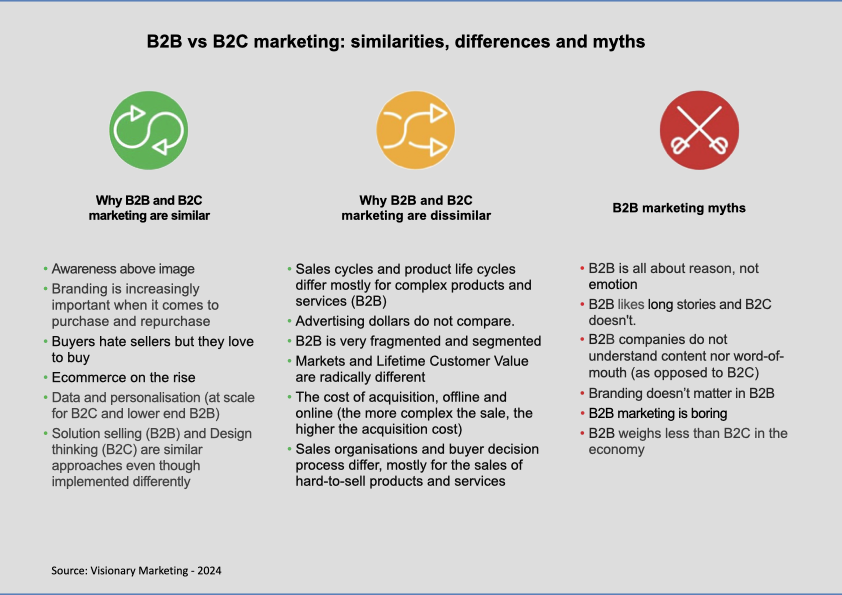
B2B vs B2C Marketing: Similarities, Differences and Myths
This seemed both exotic and inappropriate to our prospects. A steel manufacturer located in the wilderness in the east of France was my first prospective customer. This respectable gentleman couldn’t imagine himself talking to a marketer who’d designed strategies for Procter & Gamble, Unilever or Henkel. He needed someone who would talk his language. Nearly 30 years later, as B2B marketing, mostly in the high-tech sector, is gaining ground, the tide is turning. In some sectors like marketing automation, and many other areas of Martech and Salestech, for example, B2B marketing is even leading the bunch.
B2B vs B2C or B2B Plus B2C Marketing
And here comes a paradox. B2B and B2C marketing are both very dissimilar and very close to one another. Why is it? Let’s focus on the middle and top of the B2B market only and let’s forget about small and very small businesses.
First of all, there isn’t one kind of B2B marketing, there are many and especially for each industry. Besides, the tools we use for the segmentationMarket segmentation is as important in B2B as in B2C. Strictly speaking, segmenting means dividing one's market into subsets (segments) of our B2B markets are still flawed. Ultimately, no two B2B businesses are the same.
No two B2B businesses are the same.
B2B vs B2C marketing: debunking a few myths
It’s amazing how many myths there are regarding B2B marketing.
It is supposed to be a minor and boring subject. It is supposed aimed at catering for fully rational buyersThe B2B purchasing process is the result of a long life cycle often linked to a contract as there are many people to convince. who make their decisions over long periods of time in a completely organised way, under the aegis of a seamless, cross-functional organisation… and so on, and so forth.
The reality is quite different. Buyer behaviourThe Internet and social networks have revolutionized B2B buyer behavior. Most B2B buyers help themselves to the information they need in B2B has changed so much in the past few years that this kind of clichéd view bears no relevance to the reality of B2B marketing at all.
Where B2B and B2C marketing resemble each other
The elements of convergence between B2B and B2C marketing are significant: they are even evolving at a rapid pace and under the impetus, in particular, of digital.
On the one hand, the growing importance taken on by what could be called inbound marketing as opposed to outbound digital marketing. Sales are no longer dependent on the presence of a salesperson in front of a customer. That seems obvious of B2C and is now true of B2B too. The pandemic also introduced many changes in the way that B2B is sold. Nowadays, face to face is no longer mandatory, one doesn’t need to leave the office every so often. In the past ten years, most of our sales and engagements were carried out remotely with the help of web conferencing.
The Evolution of the B2B Sales Funnel
Almost 60% of buyers have already made their decision before seeing a salesperson, whose presence they do not really think it is useful. But the change is much more profound. One witnesses how much — in B2B — the marketing and sales functions are now intertwined. Patrizi described this extensively (below and on his blog).
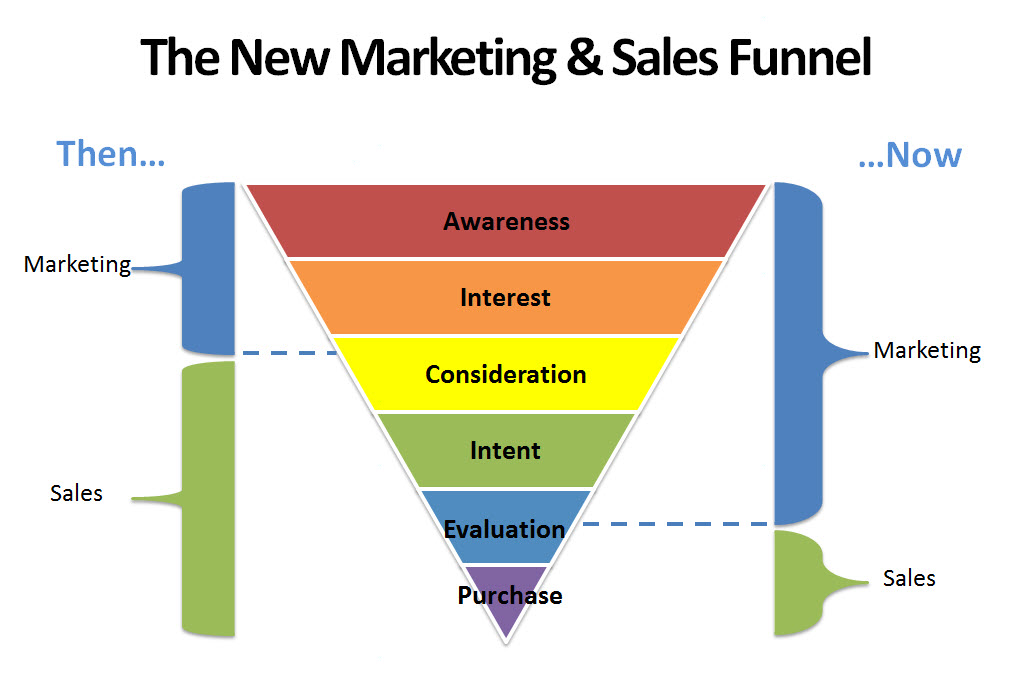
As a result, brand reputation and even brand awareness are no longer insignificant in B2B marketing. Digital plays a major role within this new landscape. Especially at a time when buyers prefer to research information independently online.
Such digital initiatives often focus on in-depth content related to the company’s pet topics. They do this through blogs, white papersThe white paper is one of the pillars of a B2B content marketing strategy. It is proof of your expertise., how-to guides, videos and so on… That being said, there has been examples where major B2B brands have demonstrated (Volvo trucks and Caterpillar in particular) that brand awareness in B2B can also be achieved through branded content.
B2B E-commerce Is on the Rise
Another consequence of the above is that the share taken by B2B e-commerce is growing. In a 2015 report, Forrester even estimated that this would account for the bulk of the e-commerce market over the next five years. In 2019, 75% of UK e-commerce (EDI+Web) was indeed B2B according to German stats firm Statista. Half of it through EDI.

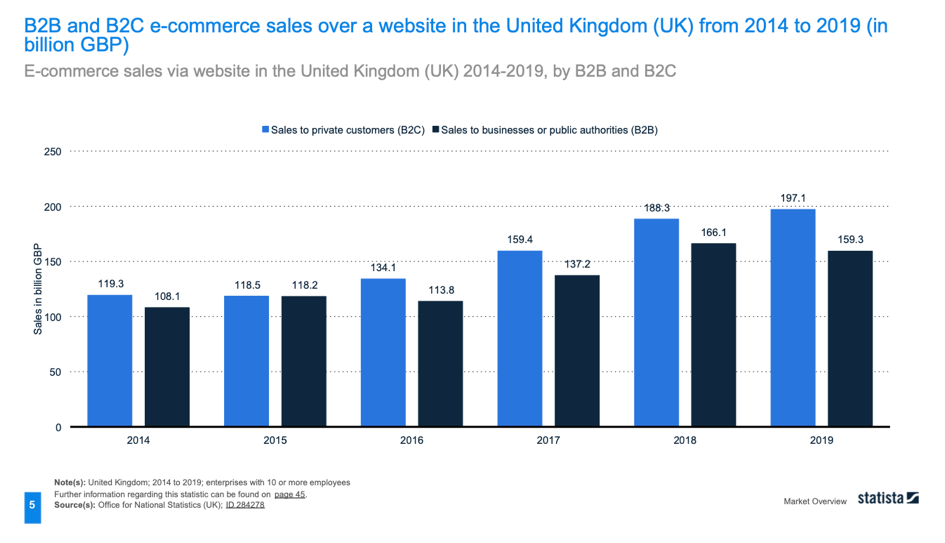
This didn’t come as a shock, given that B2B accounts for around two thirds of the economy (See here Google Translate will translate the text and numbers for you).
Massive Data
Next is the availability of data, data analytics and BI. All that makes B2B and B2C marketing ever closer to one another. On the one hand, B2C is moving away from mass marketing by opening up the prospect of mass customisation at scale (the old Peppers and Rodgers pipe dream is now within reach). On the other hand, customisation is B2B’s middle name. Nearly all complex deals, barring a few exceptions, are co-designed with clients. Better control and use of customer data blurs the boundary between B2B and B2C.
It should also be noted that, under the impetus of Big Data, B2B is moving away from the traditional sales model and investing heavily in marketing automation, lead nurturing, sales intelligence and predictive lead scoring. This phenomenon, initially confined to high-tech, is now expanding into other sectors.
Finally, service design is increasingly similar between B2B and B2C even though the names of the methodologies used differ slightly. “Solution Selling” is a staple of B2B marketing and sales. In B2C, one uses “Design Thinking”. Both methodologies focus on “customers’ painpoints” to Michael Bosworth’s vocabulary. Both involve that marketers step into their buyers’ shoes and address their main issues, while finding out what is “keeping them awake at night”.
Same Same, but different

First of all, a B2B sales cycle is often a long life cycle, most of the time tied to a contract. This sales cycle is complex and there are usually many people that need to be convinced along the way. Identifying the decision makers with whom you need to interact during that sales process is key. This decision process often takes several months, years and even possibly decades depending on how big and involved the deal is.
All Is Not Rational in B2B Land
However, it would be wrong to believe that all B2B purchases, even within key accounts, are performed rationally and according to rules edicted by procurement. Even in the IT field, many purchases are made directly by the business departments, and often via the Internet. In the highly rational and controlled field of IT, Amazon Web Services recently demonstrated, by opening its 2015 accounts, that it was possible to take a majority of the market in a B2B field (the sale of online server space). It did it with credit cards and sales processes borrowed from B2C e-commerce websites. Right from the start, it was indeed possible to open an account immediately with one’s B2C Amazon account on AWS with a standard credit card.
This is precisely what my coworkers deemed impossible when I was in charge of that business for a large telco. Next thing you knew, they were reselling AWS, QED.
Advertising Is Out of Bounds for Most B2B Businesses
Secondly, advertising dollars are scarce in B2B. If one excludes a few major American B2B players (Intel, IBM, Cisco and Microsoft), the vast majority of B2B vendors don’t do advertising. What’s more, they don’t always see the point in expanding brand awareness beyond their target audience, which is often very niche. Even though it is precisely by reaching out to users outside their target market that firms like Intel managed to emerge from nothingness. This is what made the American chip maker a long-term market leader, following Regis McKenna’s famous mantra: “Talk to your customers’ customers!”
Most of the time, however, budgets for advertising are in short supply. Most B2B players can’t spend 500 million euros in advertising, as I have seen it done in consumer marketing (in this particular example, such budget only amounted to 1.1% of the yearly revenue).
Accurately Targeted and Thrifty Strategies
As a result, B2B vendors need to devise thoroughly targeted and thrifty strategies, often based on word-of-mouth marketingWord-of-mouth marketing is a classic in B2B, it is an alternative method to traditional advertising and marketing. This is another reason why digital is playing such a big role in B2B. For years, I declared that the future of digital would be in B2B. I must have been right in that respect.
Pricing and Market Sizes
Thirdly, pricing and market sizes. B2C is about targeting segments within masses of consumers buying masses of — most of the time — low-price products.
High-end Solutions
B2B is completely different from that. Business to Business targeting is aimed at very niche populations and limited numbers of sales for — most of the time if one looks a complex selling — hefty revenues. At the same time, the purchasing process related to such deals is very complex and involves many stakeholders. I have, for example, worked on €150 million deals over 5 years. Deals like that are few and far between. They also require a lot of preliminary research and negotiations. Typically, a €150 million deal will take around two years to land.
In the firm (a large European Telco) that I was working with, all in all, the B2B arm wasn’t weighing more than 10% of the overall revenue of the business (hence, B2C sales amounted to 90%).
B2C was massive and based on a large number of very small sales. B2B, and on the other hand, was the result of a small number of very large sales.
The Cost of Selling
The cost of selling is also quite different with B2B. Firstly, because potential customers are not so numerous in B2B. But also because salespeople are infinitely more expensive in high-end B2B. You can’t just hire anyone to do complex selling, it requires skills and field expertise.
Acquisition costs are therefore much higher, and this is true not only offline, it is also verifiable online. While at the lower end of the B2B market, you can get leads for around €20, the average for the top end of the market is more likely to be between €100 to €1,000, or even more. Besides, all B2B markets are different and there is no such thing as a one-size-fit-all strategy for B2B.
Debunking a Few B2B Myths
Now you understand why things are a little more complex than most people think.
B2C and B2B are converging and diverging at the same time. Besides, there are many myths surrounding B2B marketing that need to be exposed and challenged.
On the one hand, as stated above, B2B isn’t always rational even if it appears so. Buyer’s personal agendas often must be taken into account. Any good B2B salesperson knows this. They know how to flatter their buyers and reassure them — when needed. Buying this product or service rather than its competitors may have a positive or negative impact on their career. This is in no way rational or linked to the quality of the product or service. And this isn’t particularly new either. It merely highlights the importance of branding in B2B sales.
Content Marketing and B2B
Another point, I’ve read here and there that content marketing isn’t meant for B2B that it’s a mostly a B2C thing. I think it’s the other way round. Content marketing is crucial in B2B while it’s only a nice to have in B2C. B2C is often carried out without content strategies, which are often nice-to-haves. In B2B, there is no alternative. Advertising, as pointed out above, is out of reach. It’s way too expensive and often very ineffectual too because of the fact that most high-end B2B markets are niche. Besides, in B2B, there is no dearth of content producers. Any B2B firm is jam-packed with experts, engineers, marketers, partners and visionaries. And there are also B2B content marketing agencies to support these content initiatives. In fact, this is our business.
Last but not least, B2B marketing is said to be boring, whereas B2C marketing is deemed extremely entertaining.
Nothing could be further from the truth in my honest opinion. It all depends on the topic and the type of content you’re generating. Writing a blog about yoghurt seems to me more difficult to me and certainly a lot less exciting to me than one about big data. The latter may be perused by fewer readers, but it will attract a lot of enthusiastic feedback within a genuine community of interest. Engagement in B2B, is undeniably stronger, even though it may not always happen online.
B2B vs B2C Marketing in a Nutshell
In conclusion, it is wrong to state that B2B marketing is identical to B2C marketing (that was the mistake from 40 years ago and one that we must not reproduce). It would be equally wrong to believe that the two are completely disconnected, though.
There are similarities and differences and the B2B and B2C marketing are also converging to an extent. B2C marketing may have been created a little earlier (respectively the 1960s and 1980s), but it is nonetheless undergoing considerable change. B2B marketing is no longer the poor cousin of B2C marketing.
It is even sometimes a source of inspiration for new marketing practices.
- Music and AI: Back to the Future - 07/06/2024
- Learning AI with the help of robots - 05/06/2024
- B2B vs. B2C Marketing - 13/05/2024



